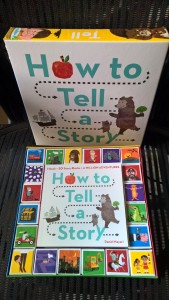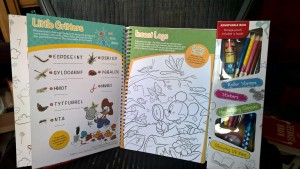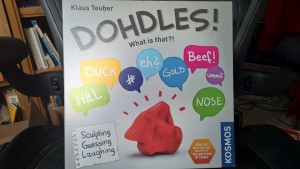Play is supposed to be fun, right? But these days, there are a lot of toys and games that take away some (or most) of the fun by having so many elaborate rules that any hope of creativity is stifled. At the same time, having no rules at all can be so overwhelming that it’s impossible to start. The best games—the ones you want to play over and over—include some basic rules but also give the players plenty of space to improvise. This week we take a look at several family games that do exactly that: give you some guidelines but then get out of the way and let you do things your own way.
 How to Tell a Story (book by Daniel Nayeri)
How to Tell a Story (book by Daniel Nayeri)
The best stories are the ones that have a basic structure and some familiar elements, such as action, conflict, and the characters’ motivation. But putting those elements together isn’t always easy. How to Tell a Story is like a creative writing workshop in a box. The 140+-page book includes some excellent insights into how to write (or just tell) a story. But the best part is the 20 story blocks, which have unique illustrations on each side. They fall into six color-coded categories: red (people or animals), blue (things), orange (places), yellow (descriptions or emotions), green (actions), and purple (relationships). The idea is to roll the blocks like dice and use what’s on each face to create your stories. You can make up your own or follow some of the prompts the author provides (“I found it,” said the [person or animal], lifting the [thing] into the air.) An absolutely wonderful way to stimulate creativity while learning how to be a better storyteller. Ages 3 and up.
 Disney Imagicademy (Wonderforge)
Disney Imagicademy (Wonderforge)
Another clever way to make learning fun. Imagicademy Animals takes kids on a tour of the animal kingdom, learning about what each species eats, where they live, how they protect themselves, and what we as humans can do to protect them and their environment. Kids and parents will love the huge variety of clever-yet-educational activities and games, such as word scrambles, crossword puzzles, animal bingo, matching games, drawing challenges, and vocabulary (did you know that a group of mice is called a “mischief”?). Imagicademy Science brings a similar approach to the world of science. Guided by the beloved characters from the movie Frozen, kids will learn about weather, physics, color, light, our five senses, and more. Both kits come with a 60-page activity book, colored pencils, stickers, a storage pouch, and more. Ages 4 and up. Only at Target http://wonderforge.com/
 Dohdles (Kosmos)
Dohdles (Kosmos)
Like most board games, the goal of Dohdles is for players to be the first to move their pawn from a starting space to an ending space. And like many board games, players can move their own pawn forward or do something to keep their opponents from advancing. Unlike most other board games, though, players don’t have to roll dice or pick cards or answer questions to move. Instead, they use modeling dough to create a small sculpture that other players will have to identify (the word doghdle, by the way, combines the words dough and riddle). The trick is to make your dohdles hard—but not impossible—to guess. The sculptor (called Dohdle Master) can score points when opponents guess correctly. Comes with plenty of modeling dough that doesn’t dry out, stain, or smear. Takes about 40 minutes to play. For 3-6 players 10 and up. http://thamesandkosmos.com/
